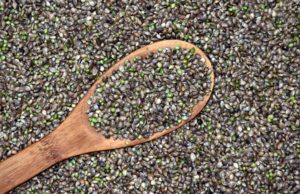Combine Settings Troubleshooting
Combine Settings – Hemp Grain
Settings need to be adjusted according to individual crop moisture and general conditions. Adjustments need to be made as the harvesting continues. Producers have found that canola, peas or bean settings for the cylinder and concave are a useful starting point for combining hemp. The air, sieve and chaffer are set similar to wheat, for a starting point.
Proper setting of the combine improves the yield and quality of the grain and reduces wear on the combine. Experiment with ground speed, concave openings, air speed etc.
Following is a suggested starting point to set a combine for harvesting of hemp.
- Cylinder Speed – 450 – 600 rpm
- Concave – 30 – 50 mm
- Wind – 1070 rpm
- Sieve – 3mm
- Chaffer – 10mm
Combining Hemp – Troubleshooting Management – Producer & Industry Experience
After 15 plus years of hemp production in Canada, producers have, through trial and error, developed and identified techniques to facilitate grain harvest. Following are some of techniques that have been identified.
- Combines manufactured in the last 10 years will harvest hemp with few modifications.
- Draper headers are preferred as there is more room for the hemp heads to lay down and feed evenly into the combine. Conventional headers are also used.
- Proper setting of the combine improves the yield and quality of the grain and reduces wear on the combine. It is important for all producers to experiment with ground speed, concave openings, sieves, wind speed etc.
- Monitor grain tank for cracking of grain and adjust settings as required.
- Adjust the concave to minimize seed cracking.
- Worn or loose chains such as feeder conveyors, internal conveyors and elevators may cause seed cracking
- Combine at 15 to 18% moisture or less. At high moisture content, a lot of plant material will be in the sample. The sieves will gum up and require frequent cleaning
- At low moisture content (close to dry), the hemp stalks shatter. There will be more fine strands of fibre that can create wrapping problems.
- Too high a fan speed will blow hemp seed out with the chaff and allow a large amount of material in the return.
- Start with a lower fan speed and gradually increase it until separation of chaff and seed occurs with no seed being blown over the chaffer sieve
- Closing the sieve tends to direct the air to the rear rather than up, but at the same time tends to increase air velocity through the sieve.
- Open the top sieve or chaffer enough for good separation (1/4 to 1/3 open, or 3 to 10 mm). This will keep the seed from going over the top and out the back of the combine. Ensure that air lifts the chaff on the sieve with a shaking action conveying the material along.
- A chaffer opening that is too narrow, coupled with insufficient wind, can result in high seed losses.
- Adjust the lower sieve depending on the sample seed quality in the grain tank. If too much residue is present in the tank, close the sieves slightly. If the sample is overly clean, seed may be going back to the return conveyor, so open the sieves slightly. A lower sieve setting at 3 to 6 mm will usually be sufficient. Excessive returns result in seed crackage and the overloading of one section of the combine, resulting in high seed losses. If the returns are too high, there may not be enough wind, the top sieve may be too open, or the cylinder-concave is over threshing.
- No more than one meter of hemp stalk should go into the combine. If plugging or wrapping in the machine happens, lift the header as this will reduce the length of the cut and therefore less material going into the combine.
- The cutter bar height should be high enough to take in the heads of the crop canopy.
- The header knife must be kept sharp at all times to minimize winding of fibers on the cutter bar.
- Remove or drop the straw chopper knives. Most choppers are fixed in the back of the machine.
- If wrapping occurs around the end of the straw chopper rotor, shields are placed on the edge of the rotor to protect wrapping on the bearings.
- Exterior rotating shafts and pulleys that may come in contact with stalks should be protected when harvesting varieties that reach the bottom of the frame of the combine.
- Mechanical drives for the header need to be protected. Factory shields help but the universal joints are usually exposed. These will pick up any fine fibers and stalks that rub by them. Protect below these shafts so the stalks do not reach them. Any opening in front of these drives can allow stalks to touch the shafts and start to wrap.



